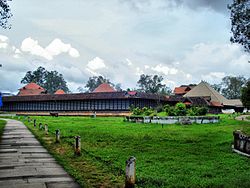The world famous colourful Thrissur Pooram festival being conducted in the temple premises here even now, though the temple is not participating in the festival. The main attraction of the Pooram is the Elanjitharamelam, a two hour Chendavadyam (with five instruments) is held near Koothambalam in the temple, by the top most artists from the state. This festival was introduced by Sakthan Thampuran (1751-1805) who was very fond of Lord Vadakkunnathan. His personal interest towards the Lord changed the fortune of the Thrissur City too.
The main deity Lord Shiva is in the form of a huge lingam, but not visible, is fully covered under a screen of ghee formed by the daily abhishekam with ghee over hundred and hundred of years. A thick ghee layer has been formed around the lingam which is now about 5.0m high with cascading crescents of gold and three serpent hoods on top. This is the only Shiva temple where lingam is not visible. It is also said that the ghee covered the lingam is not emanating any kind of foul odor and does not melt even in summer.
There are shrines for Krishna (in the form of Krishna as cowherd), Nandikeswara, Parasurama, Simhodara, Ayyappan, Vettekkaran (Lord Shiva as hunter) and Adi Shankara in the outside of the main deity shrine. There are shrines for Ganapati, Sankaranarayana, Rama, Arthanarishvara. Main festivals of this temple are Maha Shivaratri, Aanayoottu (feeding elephants).





No comments:
Post a Comment